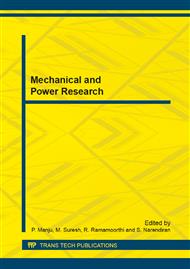[1]
C. Abbey and G. Joos, June 2004, Integration of energy storage with doubly fed induction machine for wind power applications, IEEE power electronics specialists conf., vol. 3, p.1964-(1968).
DOI: 10.1109/pesc.2004.1355418
Google Scholar
[2]
Bagen and Billinton, R, 2005, Incorporating well-being considerations in generating systems using energy storage, IEEE Trans . Energy Convers. vol. 20, no. 1 pp.225-230.
DOI: 10.1109/tec.2004.842376
Google Scholar
[3]
Barton, J.P. and Infield, D. G, 2004, Energy storage and its use with intermittent renewable energy, IEEE Trans. Energy Convers., vol. 19, no. 2, pp.441-448.
DOI: 10.1109/tec.2003.822305
Google Scholar
[4]
R. Datta and V.T. Ranganathan, sep. 2002, variable speed wind power generation using doubly fed wound rotor induction machine-a comparison with alternate schemes, IEEE Trans. Energy convers., vol. 17, no. 3, pp.414-421.
DOI: 10.1109/tec.2002.801993
Google Scholar
[5]
David Santos- Martin, Jose Luis Rodriguez-Amenedo, and Santiago Arnaltes, July 2009, Providing Ride- through capability to a Doubly Fed Induction Generator under unbalanced voltage dips , IEEE Trans. Power Electronics, vol. 24, no. 7.
DOI: 10.1109/tpel.2009.2016965
Google Scholar
[6]
J. Dannehl, C. Wessels, and F. W. Fuchs, Limitations of voltage-oriented PI current control of grid-connected PWM rectifiers with LCL filters, IEEE Trans. Ind. Electron., vol. 56, no. 2, p.380–388, Oct. (2009).
DOI: 10.1109/tie.2008.2008774
Google Scholar
[7]
R. Gagnon, Detailed Model of a Doubly-Fed Induction Generator (DFIG) Driven by a Wind Turbine The MathWork, Jan. (2006).
Google Scholar
[8]
Hatziagyriou, N. Asano. H, Iravani, R. and Marnay, C. 2007, Microgrids; an overview of on going research, development and demonstration projects, IEEE Power Energy Mag., vol. 5, no. 4, pp.78-94.
DOI: 10.1109/mpae.2007.376583
Google Scholar
[9]
Peng Zhou, Yikang He, and Dan Sun, Nov2009, Improved Direct Power Control of a DFIG-based Wind turbine during Network unbalance, IEEE Trans. Power Electronics, vol. 24, no. 11.
DOI: 10.1109/tpel.2009.2032188
Google Scholar
[10]
J. C. Vasquez, J. M. Guerrero, A. Luna, P. Rodríguez, and R. Teodorescu, Adaptive droop control applied to voltage-source inverters operating in grid-connected and islanded modes, IEEE Trans. Ind. Electron., vol. 56, no. 10, p.4088–4096, Oct. (2009).
DOI: 10.1109/tie.2009.2027921
Google Scholar
[11]
Woo Cheol Lee, Dong Myung Lee, and Taeck Kie Lee, April 2010, New Control Scheme for a Unified Power Quality Compensator-Q with minimum active power injection, IEEE. Trans, Power delivery, vol. 25, no. 2.
DOI: 10.1109/tpwrd.2009.2031556
Google Scholar
[12]
L. Xu and P. Cartwright, Direct active and reactive power control of DFIG for wind energy generation, IEEE Trans. Energy Convers., vol. 21, no. 3, p.750–758, Sep. (2006).
DOI: 10.1109/tec.2006.875472
Google Scholar
[13]
C. Xia, C. Song and T. Liu, Predictive current control of three phase grid connected converters with constant switching frequency for wind energy systems, , IEEE Trans. Ind. Electron., vol. 60, no. 6, pp.2451-2464, Jun. (2013).
DOI: 10.1109/tie.2012.2225394
Google Scholar


